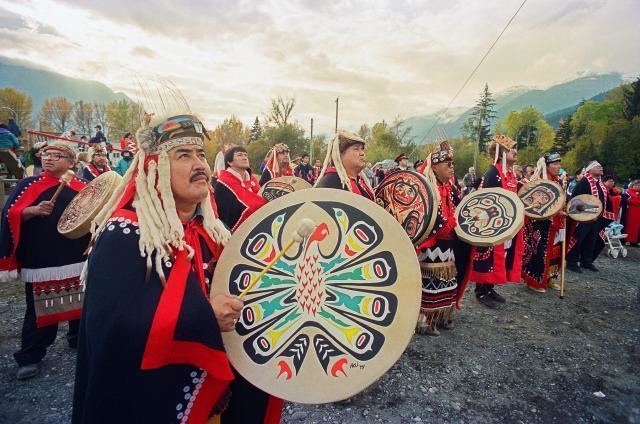Country Canada Time zone PST (UTC−8) Area 2,000 km² | Nisga'a Final Agreement (Land-claim settlement) 11 May 2000 Postal code prefix V0 Area code 250 | |
 | ||
Villages Gitlaxt'aamiks, Gitwinksihlkw, Laxgalts'ap, Gingolx | ||
Nisga a museum visit
The Nisga’a /ˈnɪsɡɑː/, often formerly spelled Nishga and spelled in the Nisga’a language as Nisg̱a’a (pronounced [nisqaʔ]), are an Indigenous people of Canada in British Columbia. They reside in the Nass River valley of northwestern British Columbia. The name is a reduced form of [naːsqaʔ], which is a loan from Tongass Tlingit, where it means "people of the Nass River".
Contents
- Nisga a museum visit
- Map of Nisgaa BC Canada
- Vital choice visits the nisga a nass river fish wheel
- Society
- Food
- Houses
- Clothing
- Where they live
- Nisgaa villages
- Nisgaa urban societies
- Nisgaa calendarlife
- Treaty
- History
- Government
- Museum
- Prominent Nisgaa
- References
Map of Nisga'a, BC, Canada
The official languages of Nisg̱a’a are the Nisg̱a’a language and English.
Vital choice visits the nisga a nass river fish wheel
Society
Nisga’a society is organized into four tribes:
Each tribe is further sub-divided into house groups – extended families with same origins. Some houses are grouped together into clans – grouping of Houses with same ancestors. Example:
Food
The Nisga’a harvested "beach food" all year round. This would include razor clams, mussels, oysters, limpets, scallops, abalone, fish, seaweed and other seafood that could be harvested from the shore. The people believed that eating too much beach food would make a person sick. They also harvested salmon, cod, char, pike, trout and other fresh water fish from the streams.
In addition, men rowed out in oceangoing canoes to hunt seals, whales, fish and sea otters. They often traded blubber with other tribes, as well as fish oil. They hunted mountain goat, marmot, game birds and more in the forests. The women cooked and processed the meat and fish, roasting or boiling the former. They ate fish and sea mammals in frozen, boiled, dried or roasted form. The heads of a type of cod, often gathered half eaten by sharks, were boiled into a soup that helped prevent colds. The Nisga′a also traded dried fish, seal oil, fish oil, blubber and cedar were traded with inland tribes.
Houses
Houses of the Nisga’a were shaped as large rectangles, made of cedar planks with cedar shake roofs. They were oriented with the doors facing the water. The doors were usually decorated with the family crest. Inside, the floor was dug down to hold the hearth and conserve temperature. Beds and boxes of possessions were placed around the walls. Around three to four extended families lived in one house. Masks and blankets decorated the walls.
Clothing
Men wore nothing in the summer, normally the best time to hunt and fish. Women wore skirts made of softened cedar bark and went topless. During the colder season, men wore cedar bark skirts (shaped more like a loincloth), a cape of cedar bark, and a basket hat outside in the rain, but wore nothing inside the house. Women wore a basket hat and cedar blankets indoors and outdoors. Both sexes made and wore shell and bone necklaces. They rubbed seal blubber into their hair, and men kept their hair long or in a top knot.
During warfare, men wore red cedar armour, a cedar helmet, and cedar loincloths. They wielded spears, clubs, harpoons, bows and slings. Wicker shields were common.
Where they live
Approximately 2,500 live in the Nass Valley (within the four villages). Another 3,500 Nisga’a live elsewhere in Canada, predominantly within the three urban societies noted in the section below.
Nisga’a villages
The Nisga’a people number about 6,000. In British Columbia, the Nisga’a Nation is represented by four villages:
Nisga’a urban societies
Many Nisga’a people have moved to cities for their opportunities. Concentrations are found in three urban areas outside traditional Nisga’a territory:
Nisga’a calendar/life
The Nisga’a calendar revolves around harvesting of foods and goods used. The original year followed the various moons throughout the year.
Treaty
On August 4, 1998, a land-claim was settled between the Nisga’a, the government of British Columbia, and the Government of Canada. As part of the settlement in the Nass River valley, nearly 2,000 square kilometres of land was officially recognized as Nisga’a, and a 300,000-cubic-decameter water reservation was also created. The Bear Glacier Provincial Park was also created as a result of this agreement. The land-claim's settlement was the first formal treaty signed by a First Nation in British Columbia since the Douglas Treaties in 1854 (pertain to majority of British Columbia) and Treaty 8 (pertaining to northeastern British Columbia) . The land that is owned collectively is currently exposed to internal pressures from the Nisga'a people to turn it over into a system of individual ownership. This would have an effect on the rest of Canada in regards to native land.
History
The Tseax Cone situated in a valley above and east of the Tseax River was the source for an eruption during the 18th century that killed approximately 2,000 Nisga’a people from poisonous volcanic gases.
Government
The government bodies of the Nisga'a include the Nisga'a Lisims government, the government of the Nisga'a Nation, and the Nisga'a village governments, one for each of the four Nisga'a villages. The Nisga'a Lisims government is embodied in the Wilp Si'Ayuukhl Nisga'a and located in the Nisga's Lisims Government Building in Gitlax̱t'aamiks.
Museum
In 2011 the Nisga'a Museum, a project of the Nisga'a Lisims government, opened in Laxgalts'ap. It contains many historical artifacts of the Nisga'a people returned after many decades in major museums beyond the Nass Valley.
